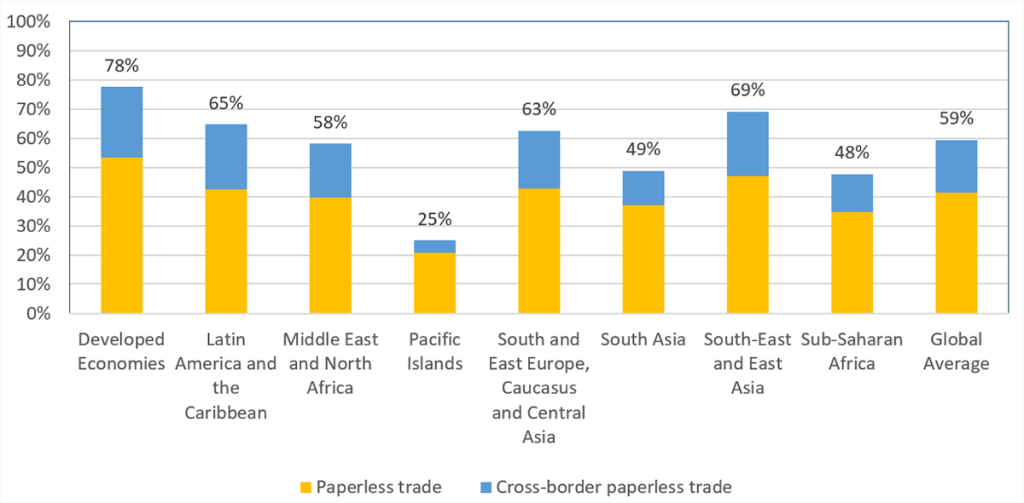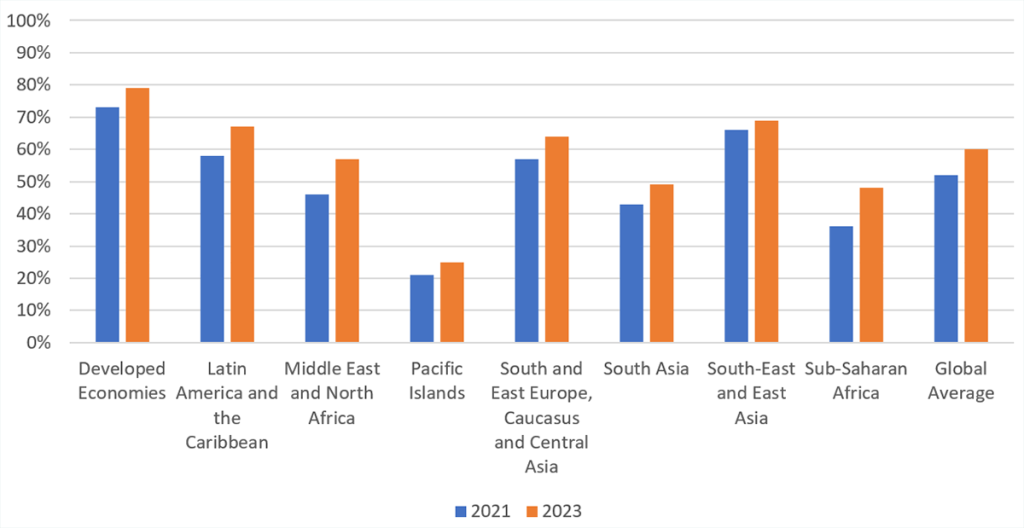Written by Yann Duval, Nolwen Prince and Chorthip Utoktham, Article No. 113, [UNCTAD Transport and Trade Facilitation Newsletter N°100 - Fourth Quarter 2023]

In the ever-evolving landscape of global trade, the advent of trade digitalization has emerged as a transformative force, leveraging information and communication technologies (ICT) and digital solutions to revolutionize traditional trade processes. Trade digitalization plays a pivotal role in enhancing the efficacy of border controls and trade administration procedures, thereby reducing trade costs and fortifying the resilience of global supply chains. The incorporation of cutting-edge technologies like Big Data analytics, Artificial Intelligence, and blockchain amplifies the efficiency, transparency, and risk management capabilities of trade processes. Crucially, digitalization addresses the challenges faced by small and medium-sized enterprises (SMEs) by mitigating the disproportionately high costs associated with trading, ushering in a new era of inclusivity and efficiency in the realm of international commerce. As we navigate the dynamic landscape of global trade, the embrace of trade digitalization emerges not merely as a choice but as a strategic imperative for a more interconnected and streamlined future.
Following the typology adopted in the UN Global Survey on Digital and Sustainable Trade Facilitation (UNTF) Survey, trade digitalization unfolds along two interconnected avenues: "paperless trade" and "cross-border paperless trade”. The former entails a shift from conventional paper-based trade documentation systems to electronic formats within each country, paving the way for streamlined processes and cost reductions. On the other hand, cross-border paperless trade focuses on fostering the legal recognition and exchange of trade-related data and documents in electronic form across national boundaries with trade partner countries.
In this context, we introduce below a new metric derived from the UNTF Survey, called the Trade Digitalization Index (TDI). Leaders in trade digitalization across world regions are identified based on the TDI. Progress made from 2021 to 2023 are discussed and a way forward suggested to accelerate progress.
The Trade Digitalization Index
While the UNTF Survey covers 60 measures, the Trade Digitalization Index specifically focuses on the 16 key measures[1] tied to the digitalization aspects of trade. The Global Survey database at www.untfsurvey.org provides an implementation score, ranging from zero to three, for each of the digital trade facilitation measures listed in table 1. The overall index reflects how well a country performs across the digitalization measures, calculated as the total implementation score divided by the maximum achievable score. This index serves as a benchmark for nations aiming to gauge and enhance their advancements in trade digitalization, offering a comprehensive understanding of the evolving landscape and promoting sustainable, digitally driven trade facilitation.
Table 1- List of Digital Trade Facilitation Measures considered in the Trade Digitalization Index
| Sub-groups | Measures |
| Paperless trade | Automated Customs System |
| Internet connection available to Customs and other trade control agencies | |
| Electronic Single Window System | |
| Electronic submission of Customs Declarations | |
| Electronic application and issuance of import and export permit | |
| Electronic submission of Sea Cargo Manifests | |
| Electronic submission of Air Cargo Manifests | |
| Electronic application and issuance of Preferential Certificate of Origin | |
| E-Payment of Customs Duties and Fees | |
| Electronic application for Customs refunds | |
| Cross-border paperless trade | Laws and regulations for electronic transactions |
| Recognized certification authority | |
| Electronic exchange of Customs Declaration | |
| Electronic exchange of Certificate of Origin | |
| Electronic exchange of Sanitary and Phyto-Sanitary Certificate | |
| Paperless collection of payment from a documentary letter of credit |
Trade Digitalization in 2023
In the landscape of trade digitalization in 2023, Figure 1 unveils the average trade digitalization rates across regions. Notably, there is a 53-percentage-point range in implementation rates across regions and significant variations within them. For instance, in the Middle East and North Africa, rates range from 31% in Yemen to 91% in Saudi Arabia, averaging out to 58% for the region. Among individual countries, leaders in overall trade digitalization rates include the Netherlands and New Zealand at 96%, alongside Australia, Belgium, the Republic of Korea, and Singapore at 93%. In developing regions, Singapore and the Republic of Korea lead South-East and East Asia at 93%, while Brazil and Peru top Latin America and the Caribbean at 91%. Saudi Arabia leads the Middle East and North Africa at 91%. In South and East Europe, Caucasus, and Central Asia, Uzbekistan leads at 89%, followed by Azerbaijan and Turkey at 80%. India boasts the highest implementation rate in South Asia at 87%. Notably, advanced economies generally outperform developing ones in trade digitalization, reflecting the need for high cooperation levels for full implementation. These disparities underscore the global call for collaborative efforts to achieve effective trade digitalization.
Figure 1- Trade Digitalization Index - Scores across world regions

Source: Authors, based on data from www.untfsurvey.org
The Evolution of Trade Digitalization
Figure 2 presents a picture of the evolving landscape of trade facilitation progress between 2021 and 2023, with a focus on regional implementation rates. Notably, the global implementation rate has surged by a 8 percentage points during this period for countries participating in both surveys. The standout achievers in this trajectory are Sub-Saharan Africa, demonstrating an impressive 12-percentage-point increase, closely followed by the Middle East and North Africa region, which has seen an 11-percentage-point rise.
However, the contrast is evident in two regions experiencing the lowest growth: the Pacific Islands and South-East and East Asia. The Pacific Islands, in particular, raise concerns as they not only exhibit the slowest growth but also possess the lowest trade digitalization score.
While progress is evident, there remains ample room for improvement. The journey toward enhanced trade facilitation is ongoing, calling for continued efforts and collaboration to bridge the existing gaps and propel global trade into a more streamlined and efficient future.
Figure 2 - Trade Digitalization Index - Evolution across World regional between 2021 and 2023

Source: Authors, based on data from www.untfsurvey.org
Way forward
The TDI results revealed strong disparities across countries and regions and much scope for progress to achieve fully digitalized trade and seamless electronic trade data and documents flow along international supply chains. The practicalities of implementing cross-border paperless trade underscore the need for collaborative efforts beyond individual countries, building on existing international standards and pilot testing of different mechanisms and solutions – some of which may be explored through a new cross-border paperless trade database available at www.digitalizetrade.org.
Coordinating practices across multiple nations requires a pragmatic approach backed by strong political commitments, emphasizing the importance of intergovernmental agreements at bilateral, regional and multilateral levels to ensure progress and collaboration can be sustained over time. Examples of such agreements include bilateral agreements for the electronic exchange of one or more specific documents, the ASEAN Single Window Agreement, the Framework Agreement on Facilitation of Cross-Border Paperless Trade in Asia and the Pacific, as well as broader digital trade or economic partnership agreements. These frameworks provide a structured basis for improved digital trade cooperation, acknowledging the necessity of working together to navigate the complexities of cross-border transactions.
[1] The measure "Electronic submission of Sea Cargo Manifests" is excluded because it is not pertinent to all national contexts.




